University Financial Report: Budget and Variance Analysis
VerifiedAdded on 2022/12/19
|7
|970
|79
Report
AI Summary
This report presents a comprehensive analysis of budget and variance, focusing on the financial performance of a business. It begins with an executive summary that highlights the key aspects of the budget and budgetary control system. The report then delves into the introduction, explaining the process of forecasting and financial planning. A detailed variance analysis compares the budgeted figures with the actual financial results, calculating variances for revenue and expenses components. The report identifies favorable and unfavorable variances, providing insights into the reasons behind these deviations. Recommendations are provided to address the variances, such as revising pricing strategies, renegotiating supplier contracts, and implementing better inventory management. The report concludes with references to relevant academic sources supporting the analysis and recommendations.
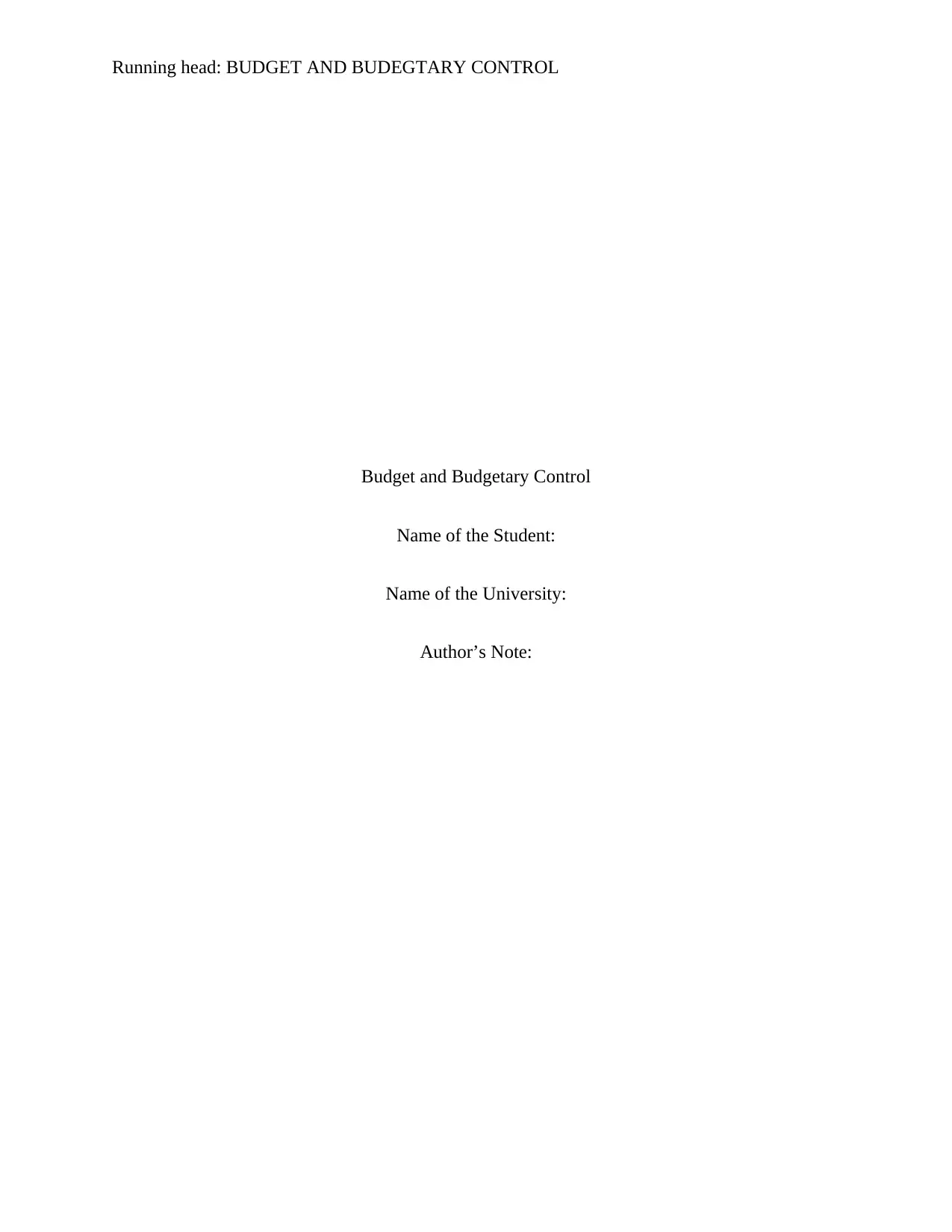
Running head: BUDGET AND BUDEGTARY CONTROL
Budget and Budgetary Control
Name of the Student:
Name of the University:
Author’s Note:
Budget and Budgetary Control
Name of the Student:
Name of the University:
Author’s Note:
Paraphrase This Document
Need a fresh take? Get an instant paraphrase of this document with our AI Paraphraser
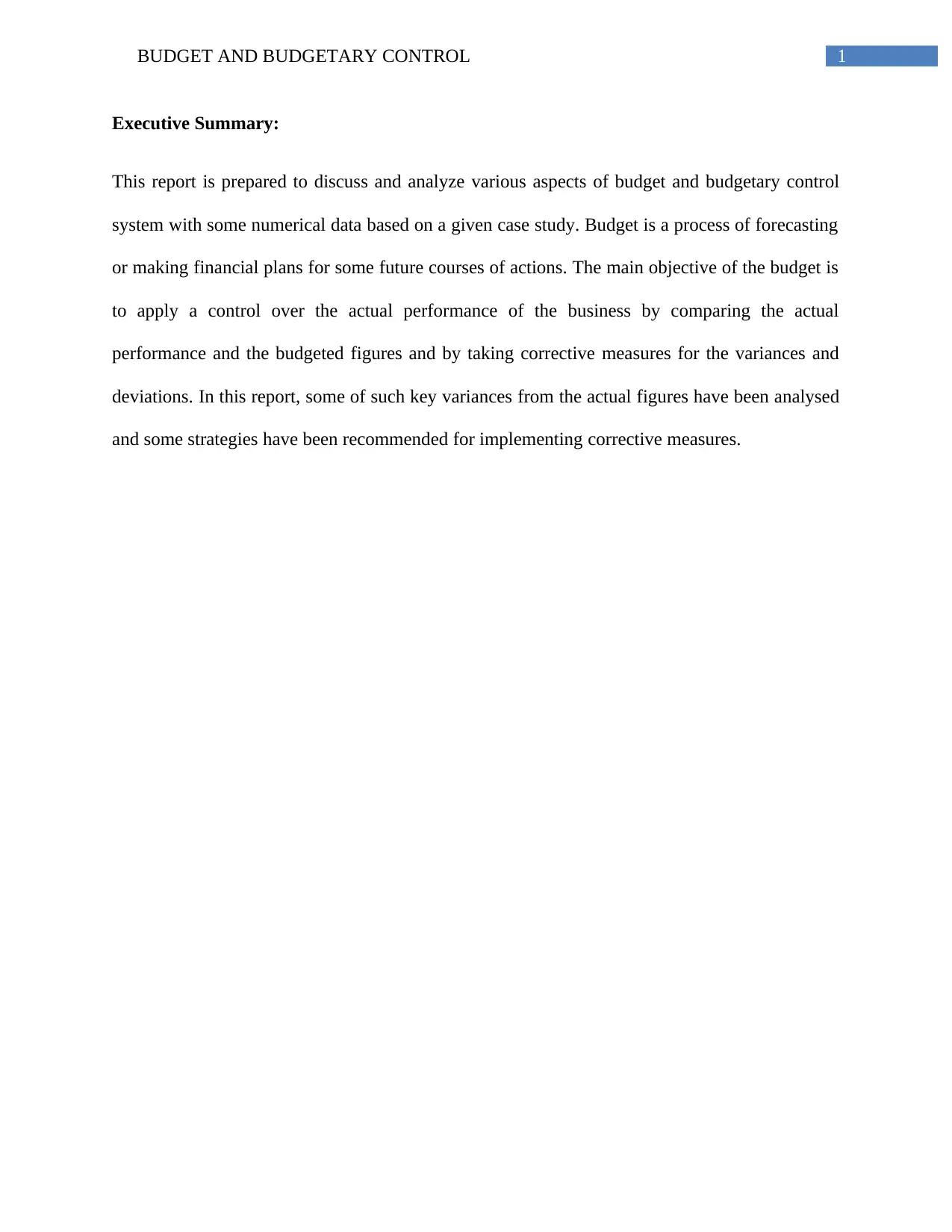
1BUDGET AND BUDGETARY CONTROL
Executive Summary:
This report is prepared to discuss and analyze various aspects of budget and budgetary control
system with some numerical data based on a given case study. Budget is a process of forecasting
or making financial plans for some future courses of actions. The main objective of the budget is
to apply a control over the actual performance of the business by comparing the actual
performance and the budgeted figures and by taking corrective measures for the variances and
deviations. In this report, some of such key variances from the actual figures have been analysed
and some strategies have been recommended for implementing corrective measures.
Executive Summary:
This report is prepared to discuss and analyze various aspects of budget and budgetary control
system with some numerical data based on a given case study. Budget is a process of forecasting
or making financial plans for some future courses of actions. The main objective of the budget is
to apply a control over the actual performance of the business by comparing the actual
performance and the budgeted figures and by taking corrective measures for the variances and
deviations. In this report, some of such key variances from the actual figures have been analysed
and some strategies have been recommended for implementing corrective measures.
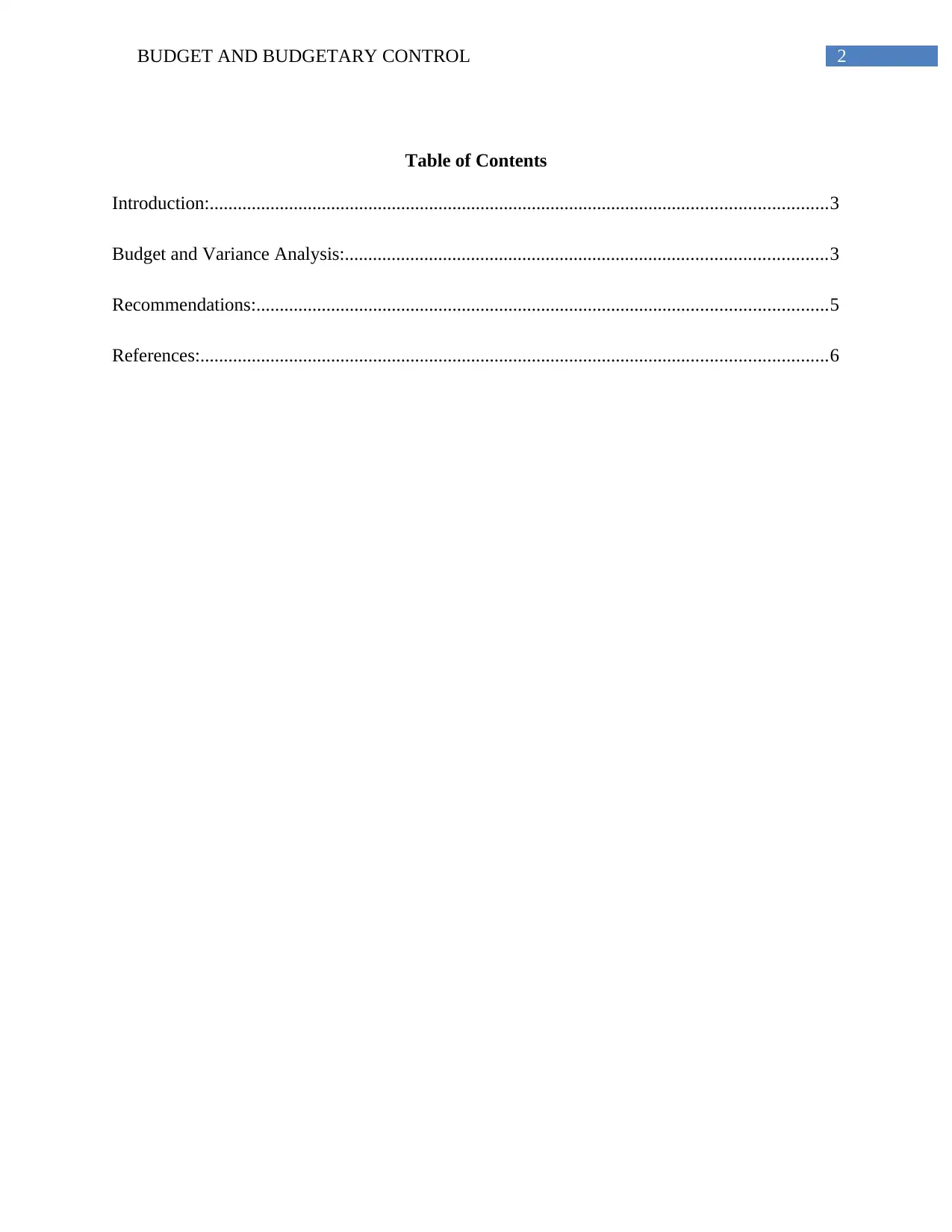
2BUDGET AND BUDGETARY CONTROL
Table of Contents
Introduction:....................................................................................................................................3
Budget and Variance Analysis:.......................................................................................................3
Recommendations:..........................................................................................................................5
References:......................................................................................................................................6
Table of Contents
Introduction:....................................................................................................................................3
Budget and Variance Analysis:.......................................................................................................3
Recommendations:..........................................................................................................................5
References:......................................................................................................................................6
⊘ This is a preview!⊘
Do you want full access?
Subscribe today to unlock all pages.

Trusted by 1+ million students worldwide
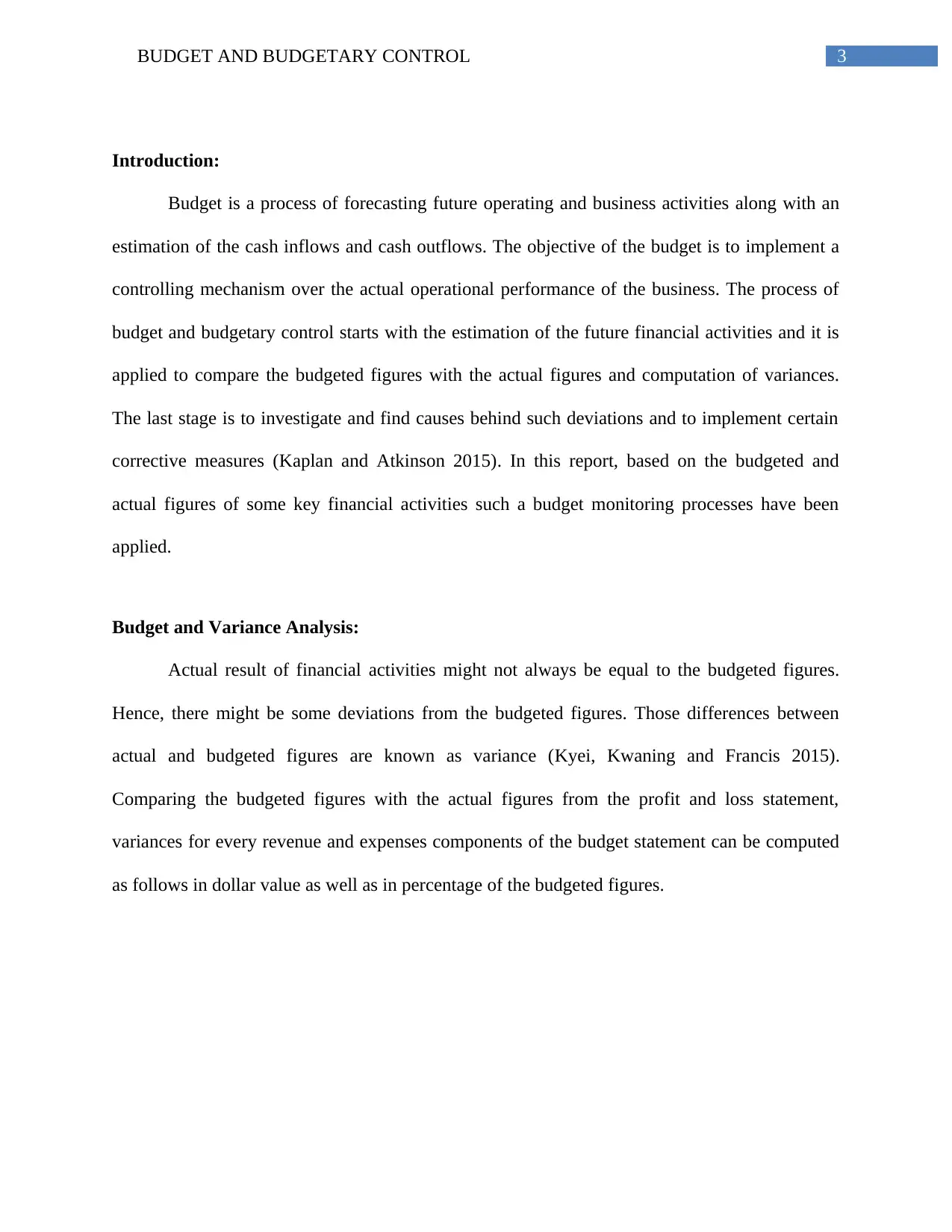
3BUDGET AND BUDGETARY CONTROL
Introduction:
Budget is a process of forecasting future operating and business activities along with an
estimation of the cash inflows and cash outflows. The objective of the budget is to implement a
controlling mechanism over the actual operational performance of the business. The process of
budget and budgetary control starts with the estimation of the future financial activities and it is
applied to compare the budgeted figures with the actual figures and computation of variances.
The last stage is to investigate and find causes behind such deviations and to implement certain
corrective measures (Kaplan and Atkinson 2015). In this report, based on the budgeted and
actual figures of some key financial activities such a budget monitoring processes have been
applied.
Budget and Variance Analysis:
Actual result of financial activities might not always be equal to the budgeted figures.
Hence, there might be some deviations from the budgeted figures. Those differences between
actual and budgeted figures are known as variance (Kyei, Kwaning and Francis 2015).
Comparing the budgeted figures with the actual figures from the profit and loss statement,
variances for every revenue and expenses components of the budget statement can be computed
as follows in dollar value as well as in percentage of the budgeted figures.
Introduction:
Budget is a process of forecasting future operating and business activities along with an
estimation of the cash inflows and cash outflows. The objective of the budget is to implement a
controlling mechanism over the actual operational performance of the business. The process of
budget and budgetary control starts with the estimation of the future financial activities and it is
applied to compare the budgeted figures with the actual figures and computation of variances.
The last stage is to investigate and find causes behind such deviations and to implement certain
corrective measures (Kaplan and Atkinson 2015). In this report, based on the budgeted and
actual figures of some key financial activities such a budget monitoring processes have been
applied.
Budget and Variance Analysis:
Actual result of financial activities might not always be equal to the budgeted figures.
Hence, there might be some deviations from the budgeted figures. Those differences between
actual and budgeted figures are known as variance (Kyei, Kwaning and Francis 2015).
Comparing the budgeted figures with the actual figures from the profit and loss statement,
variances for every revenue and expenses components of the budget statement can be computed
as follows in dollar value as well as in percentage of the budgeted figures.
Paraphrase This Document
Need a fresh take? Get an instant paraphrase of this document with our AI Paraphraser
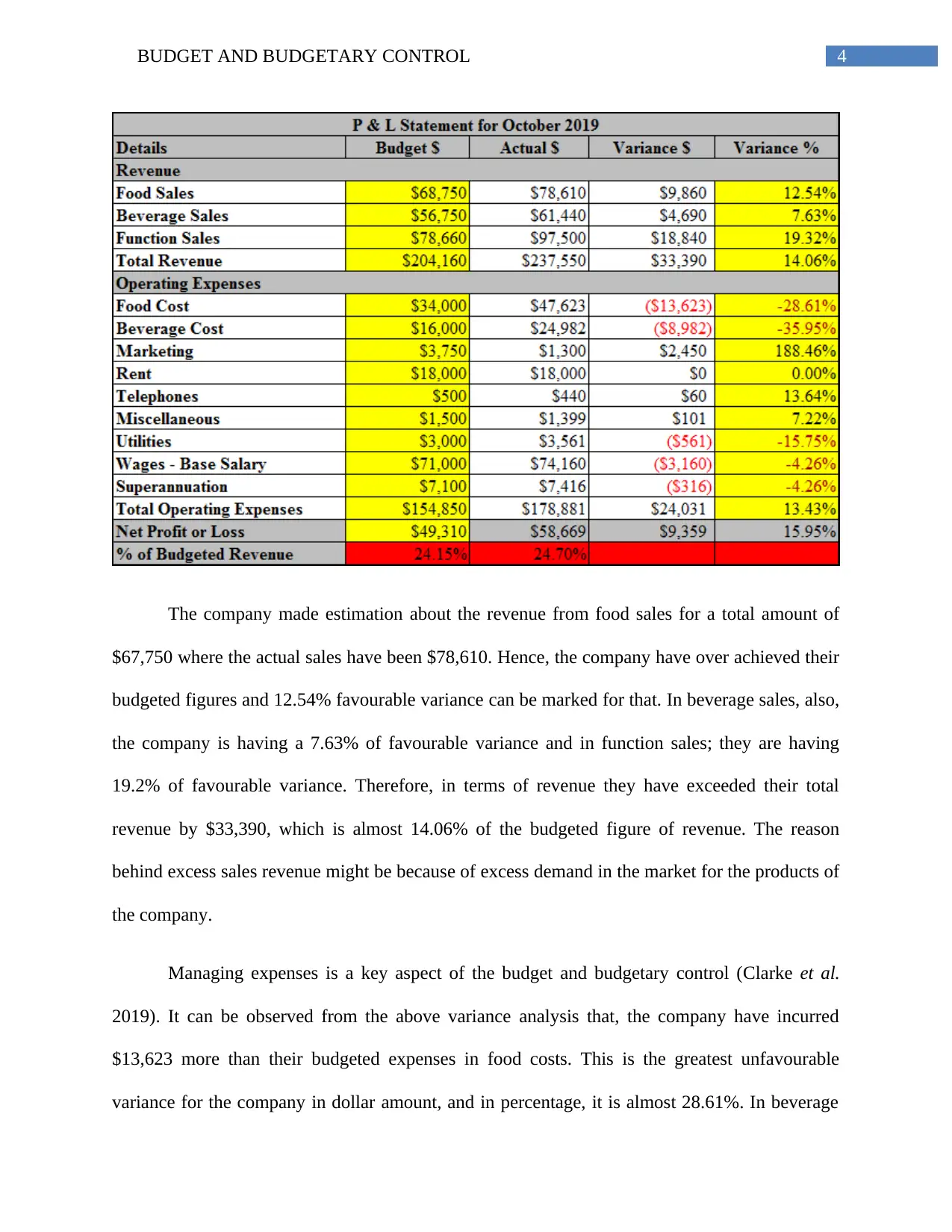
4BUDGET AND BUDGETARY CONTROL
The company made estimation about the revenue from food sales for a total amount of
$67,750 where the actual sales have been $78,610. Hence, the company have over achieved their
budgeted figures and 12.54% favourable variance can be marked for that. In beverage sales, also,
the company is having a 7.63% of favourable variance and in function sales; they are having
19.2% of favourable variance. Therefore, in terms of revenue they have exceeded their total
revenue by $33,390, which is almost 14.06% of the budgeted figure of revenue. The reason
behind excess sales revenue might be because of excess demand in the market for the products of
the company.
Managing expenses is a key aspect of the budget and budgetary control (Clarke et al.
2019). It can be observed from the above variance analysis that, the company have incurred
$13,623 more than their budgeted expenses in food costs. This is the greatest unfavourable
variance for the company in dollar amount, and in percentage, it is almost 28.61%. In beverage
The company made estimation about the revenue from food sales for a total amount of
$67,750 where the actual sales have been $78,610. Hence, the company have over achieved their
budgeted figures and 12.54% favourable variance can be marked for that. In beverage sales, also,
the company is having a 7.63% of favourable variance and in function sales; they are having
19.2% of favourable variance. Therefore, in terms of revenue they have exceeded their total
revenue by $33,390, which is almost 14.06% of the budgeted figure of revenue. The reason
behind excess sales revenue might be because of excess demand in the market for the products of
the company.
Managing expenses is a key aspect of the budget and budgetary control (Clarke et al.
2019). It can be observed from the above variance analysis that, the company have incurred
$13,623 more than their budgeted expenses in food costs. This is the greatest unfavourable
variance for the company in dollar amount, and in percentage, it is almost 28.61%. In beverage
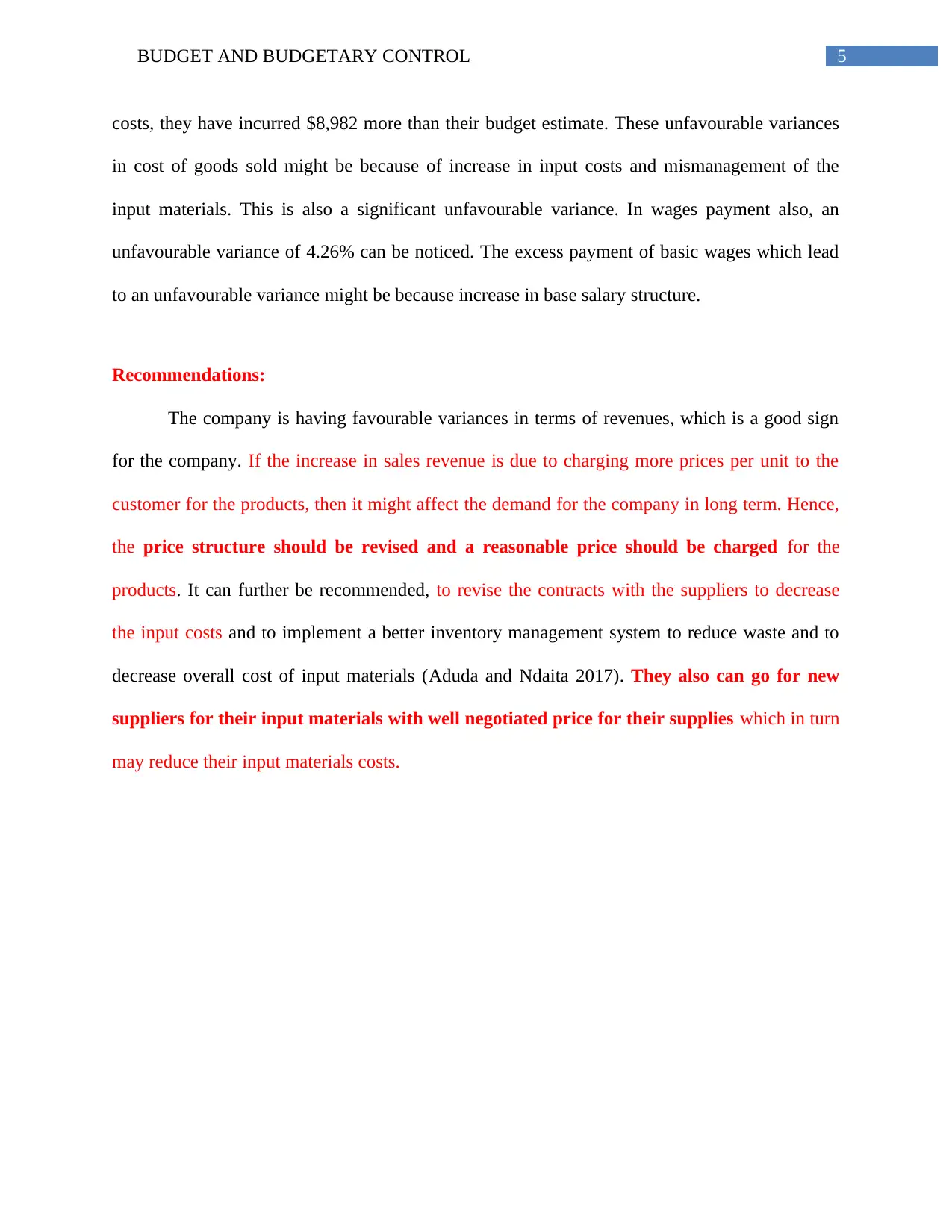
5BUDGET AND BUDGETARY CONTROL
costs, they have incurred $8,982 more than their budget estimate. These unfavourable variances
in cost of goods sold might be because of increase in input costs and mismanagement of the
input materials. This is also a significant unfavourable variance. In wages payment also, an
unfavourable variance of 4.26% can be noticed. The excess payment of basic wages which lead
to an unfavourable variance might be because increase in base salary structure.
Recommendations:
The company is having favourable variances in terms of revenues, which is a good sign
for the company. If the increase in sales revenue is due to charging more prices per unit to the
customer for the products, then it might affect the demand for the company in long term. Hence,
the price structure should be revised and a reasonable price should be charged for the
products. It can further be recommended, to revise the contracts with the suppliers to decrease
the input costs and to implement a better inventory management system to reduce waste and to
decrease overall cost of input materials (Aduda and Ndaita 2017). They also can go for new
suppliers for their input materials with well negotiated price for their supplies which in turn
may reduce their input materials costs.
costs, they have incurred $8,982 more than their budget estimate. These unfavourable variances
in cost of goods sold might be because of increase in input costs and mismanagement of the
input materials. This is also a significant unfavourable variance. In wages payment also, an
unfavourable variance of 4.26% can be noticed. The excess payment of basic wages which lead
to an unfavourable variance might be because increase in base salary structure.
Recommendations:
The company is having favourable variances in terms of revenues, which is a good sign
for the company. If the increase in sales revenue is due to charging more prices per unit to the
customer for the products, then it might affect the demand for the company in long term. Hence,
the price structure should be revised and a reasonable price should be charged for the
products. It can further be recommended, to revise the contracts with the suppliers to decrease
the input costs and to implement a better inventory management system to reduce waste and to
decrease overall cost of input materials (Aduda and Ndaita 2017). They also can go for new
suppliers for their input materials with well negotiated price for their supplies which in turn
may reduce their input materials costs.
⊘ This is a preview!⊘
Do you want full access?
Subscribe today to unlock all pages.

Trusted by 1+ million students worldwide
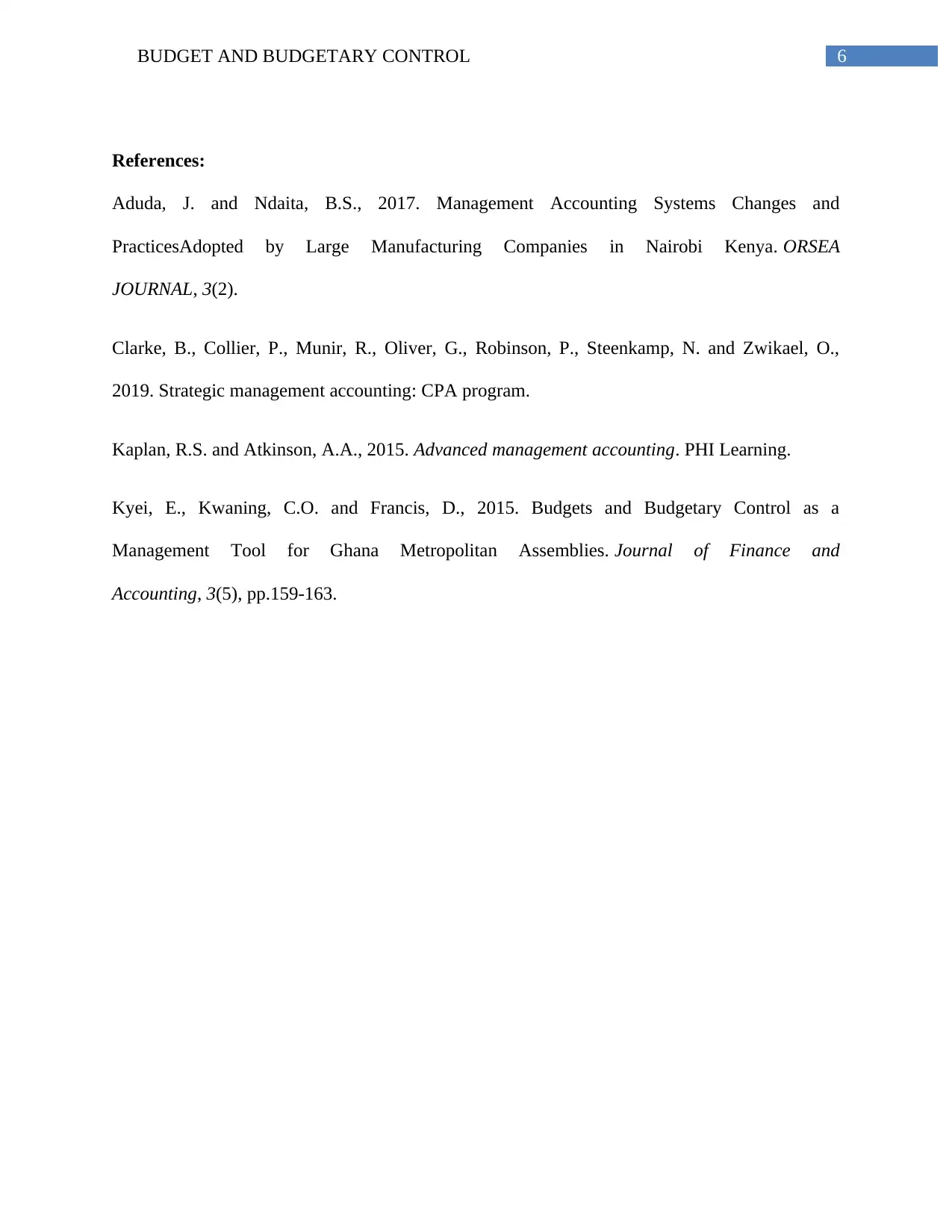
6BUDGET AND BUDGETARY CONTROL
References:
Aduda, J. and Ndaita, B.S., 2017. Management Accounting Systems Changes and
PracticesAdopted by Large Manufacturing Companies in Nairobi Kenya. ORSEA
JOURNAL, 3(2).
Clarke, B., Collier, P., Munir, R., Oliver, G., Robinson, P., Steenkamp, N. and Zwikael, O.,
2019. Strategic management accounting: CPA program.
Kaplan, R.S. and Atkinson, A.A., 2015. Advanced management accounting. PHI Learning.
Kyei, E., Kwaning, C.O. and Francis, D., 2015. Budgets and Budgetary Control as a
Management Tool for Ghana Metropolitan Assemblies. Journal of Finance and
Accounting, 3(5), pp.159-163.
References:
Aduda, J. and Ndaita, B.S., 2017. Management Accounting Systems Changes and
PracticesAdopted by Large Manufacturing Companies in Nairobi Kenya. ORSEA
JOURNAL, 3(2).
Clarke, B., Collier, P., Munir, R., Oliver, G., Robinson, P., Steenkamp, N. and Zwikael, O.,
2019. Strategic management accounting: CPA program.
Kaplan, R.S. and Atkinson, A.A., 2015. Advanced management accounting. PHI Learning.
Kyei, E., Kwaning, C.O. and Francis, D., 2015. Budgets and Budgetary Control as a
Management Tool for Ghana Metropolitan Assemblies. Journal of Finance and
Accounting, 3(5), pp.159-163.
1 out of 7
Related Documents
Your All-in-One AI-Powered Toolkit for Academic Success.
+13062052269
info@desklib.com
Available 24*7 on WhatsApp / Email
![[object Object]](/_next/static/media/star-bottom.7253800d.svg)
Unlock your academic potential
Copyright © 2020–2025 A2Z Services. All Rights Reserved. Developed and managed by ZUCOL.





